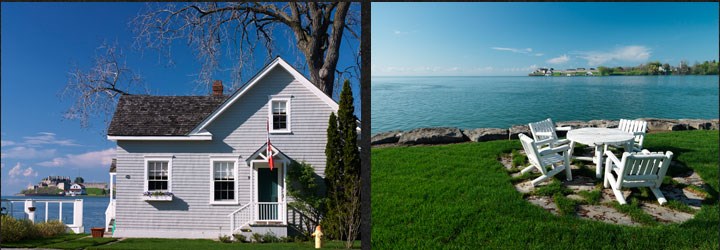
The Niagara Foundation has been quietly preserving Niagara-on-the-Lake’s heritage since 1962.
It’s been a little less quiet lately, wanting to be more active and speak out about concerns over current residential developments working their way through the town’s planning process, says Foundation president Janice Thomson, speaking for its board.
The Foundation, established as a voluntary charitable organization to promote the history, traditions and culture of the community, has accomplished much during its decades of dedication to heritage preservation. Its list of initiatives begins with its restoration of The Apothecary on Queen Street, which it purchased in 1965, with the support of Ontario Heritage, now owners of the building.
Other projects include the restoration of St. Mark’s Church Manse, the steeple at St. Andrew’s Church, the William Steward House, the William Gollop House, and the Foghorn House, on the Niagara River, renovated by the Foundation, upgraded for vacation rental accommodation. It is now owned by the town, with rentals handled through a vacation rental company.
It has also restored two 19th century carriages, and obtained a hearse which was manufactured locally. Ownership was transferred to a local funeral home, and it has been restored and is available for use.
Foundation members have recently turned their attention to two large-scale residential developments proposed for significant heritage properties, the former Parliament Oak block and Solmar’s application for a subdivision on John and Charlotte Streets, bordering the Rand Estate property.
Regarding the King Street property, a letter from Thomson and all board members asks council to examine the zoning issue, which shows the block as open space and community facilities in the Official Plan, which allows for active and passive neighbourhood parks, elementary schools, health care facilities, churches, day care centres, cemeteries, museums, historic sites and similar community servicing uses. Secondary uses would include minor sports fields, playground equipment, associated parking areas and small concession stands.
Again, according to the Official Plan, the Foundation points out, the
property may be redeveloped for low density residential use, subject to a site specific zoning bylaw amendment.
But “how does the current proposal qualify as low density residential,” the Foundation board asks.
That was a question also raised by residents who were given a glance at the proposal in June, which included, a dozen semi-detached, 1.5 storey homes, plus a three-storey apartment building on the block bordered by King, Gage, Centre and Regent Streets.
“We look forward to engaging in public discussions with council on this matter and wish to emphasize that the intention of The Niagara Foundation is to see appropriate development that maintains and complements the town’s special heritage and architectural elements, with a clearly expressed policy that allows both applicants and Town staff to meet established requirements,” the Foundation letter to council states.
In connection with the 191-unit subdivision proposed by Solmar for portions of the Rand Estate, the Foundation board believes the property to be “one of the last remaining and most important estate lots in Niagara-on-the-Lake, and strongly objects to this proposal for several reasons,” including its heritage features of local and provincial significance; the mature and possibly heritage trees on the property, 100 of which may be removed; and the proposal to elevate a portion of the site by up to 10 feet.
“We have seen calculations suggesting that 10,000 truckloads of soil will be required to accomplish this elevation change, an action that will surely decimate any remaining cultural heritage landscape features on the site,” says the Foundation letter.
It also raises concerns about the flow of water into One Mile Creek being impacted, the possibility of flooding, and access to the subdivision from 200 John Street that crosses elements of the historic Dunington-Grubb designed landscape.
“Overall, The Niagara Foundation believes the subdivision proposal should be reviewed from the perspective of the community; namely, how will the subdivision connect with and affect the historical and natural heritage of the community?”
Previous development of the Rand properties, including Christopher Street and Weatherstone Court, “were well-integrated with adjacent properties, did not require site elevation changes of this magnitude, and respected existing tolerances for density.”
The Foundation urges the town to seek a type and scale of development appropriate to the cultural history of NOTL, and one that “complements, not overwhelms, the neighbouring residential areas and meets all legislative requirements.”
Many of the same concerns have been brought up by residents about both properties, and in the case of the Parliament Oak proposal, the developer has gone back to the drawing board as a result of those comments.
The intention of the letters was to “remind people of what is important to keeping community values intact,” says Thomson.
Board members hope to be involved in future discussion of those two proposals, with the intention of seeing “appropriate development that maintains and complements the town’s special heritage and architectural elements, with a clearly expressed policy that allows both applicants and town staff to meet established requirements.”
They also look forward to seeing the report on the closed-session planning workshop councillors attended last week, which should give some indication of how applications such as these two will be dealt with in the future, says Thomson.
What was discussed at the workshop, says Lord Mayor Betty Disero, had to do with the abilities and limitations of staff and council when dealing with planning issues. The discussion had to take place in a closed session because “there could be legal ramifications going forward.”
Council has not seen reports from staff on either development proposal, she says, and she’s not sure when they will. “But there will be opportunities for the Niagara Foundation board members and the public to be involved” in future open house and planning meetings.